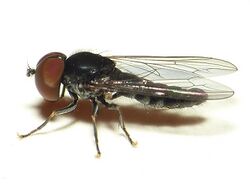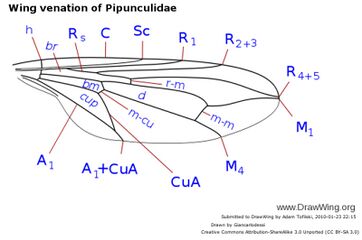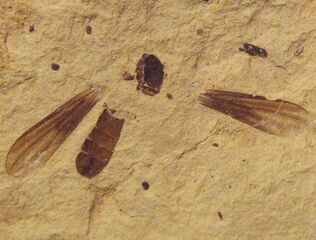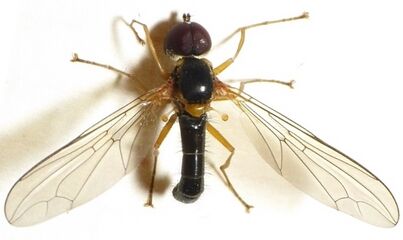Biology:Pipunculidae
| Pipunculidae | |
|---|---|

| |
| Verrallia aucta, Chalarinae | |
| Scientific classification | |
| Domain: | Eukaryota |
| Kingdom: | Animalia |
| Phylum: | Arthropoda |
| Class: | Insecta |
| Order: | Diptera |
| Superfamily: | Syrphoidea |
| Family: | Pipunculidae Walker, 1834 |
| Subfamilies | |
| |
| Synonyms | |
| |
Pipunculidae is a family of flies (Diptera) commonly termed big-headed flies,[1] a reference to the large (holoptic) eyes, which cover nearly the entire head. The family is found worldwide and more than 1300 species have been described.
The larvae of Pipunculidae develop as parasitoids almost exclusively in Auchenorrhyncha, the exception being the genus Nephrocerus, whose hosts are adult Tipulidae (crane flies). The larvae develop rapidly within the crane flies before pupating in the soil.[2] In all pipunculids there are only two larval stages. Some species are used as biological control agents in rice fields.
Taxonomy
Taxonomy as shown at the Tree of life,[3] with modification based on Kehlmaier, Dierick and Skevington (2014).[4] The name Pipunculidae is derived from the type genus Pipunculus which is thought to be derived from Latin pepo for pumpkin, thus pipunculus would mean "little pumpkin", referring to the large heads.[5]
Subfamily Chalarinae
- Genus Chalarus Walker, 1834[6]
- Genus Jassidophaga Aczél, 1939[7]
- Genus †Protoverrallia Aczél, 1948 Baltic amber Eocene (Priabonian)
- Genus Verrallia Mik, 1899[8]
Subfamily Nephrocerinae
- Tribe Nephrocerini
- Genus Nephrocerus Zetterstedt, 1838[9]
- Tribe incertae sedis
- Genus †Priabona Archibald, Kehlmaier & Mathewes, 2014 Florissant Formation, Eocene (Priabonian)
Subfamily Protonephrocerinae
- Genus Protonephrocerus Collin, 1931[10]
- Genus †Metanephrocerus Carpenter & Hull, 1939 Klondike Mountain Formation,Washington, Eocene (Ypresian) Baltic amber Eocene (Priabonian)
Subfamily Pipunculinae
- Tribe Cephalopsini
- Genus Cephalops Fallén, 1810[11]
- Genus Cephalosphaera Enderlein, 1936[12]
- Tribe Microcephalopsini
- Genus Collinias Aczél, 1940[13]
- Genus Microcephalops De Meyer, 1989[14]
- Tribe Eudorylini
- Genus Allomethus Hardy, 1943[15]
- Genus Amazunculus Rafael, 1986[16]
- Genus Basileunculus Rafael, 1987[17]
- Genus Claraeola Aczél, 1940[13]
- Genus Clistoabdominalis Skevington, 2001[18]
- Genus Dasydorylas Skevington, 2001[18]
- Genus Elmohardyia Rafael, 1987[19]
- Genus Eudorylas Aczél, 1940[13]
- Tribe Tomosvaryellini
- Genus Dorylomorpha Aczél, 1939[7]
- Genus Tomosvaryella Aczél, 1939[7]
- Tribe Pipunculini
- Genus Pipunculus Latreille, 1802[20]
Gallery
Nephrocerus scutellatus,
NephrocerinaeClistoabdominalis ruralis, Eudorylini, Pipunculinae
See also
References
- ↑ Coe, R.L. (1966). Pipunculidae. Handbooks for the Identification of British Insects. 10. pp. 83. https://www.royensoc.co.uk/wp-content/uploads/2022/01/Vol10_Part02c.pdf. Retrieved 22 July 2022.
- ↑ Koenig, D.P. & C.W. Young. (January 2007). "First observation of parasitic relations between bigheaded flies of the genus Nephrocerus (Diptera: Pipunculidae) and crane flies of the genus Tipula (Diptera: Tupulidae: Tipulinae), with larval and puparial descriptions of Nephrocerus atrapilus Skevington.". Proceedings of the Entomological Society of Washington (Washington DC: Allen Press/The Entomological Society of Washington) 109 (1): 52–65. ISSN 0013-8797.
- ↑ Pipunculidae at the Tree of life
- ↑ Kehlmaier, C; Dierick, M; Skevington, JH (2014). "Micro-CT studies of amber inclusions reveal internal genitalic features of big-headed flies, enabling a systematic placement of Metanephrocerus Aczel, 1948 (Insecta: Diptera: Pipunculidae)". Arthropod Systematics & Phylogeny 72 (1): 23–36. doi:10.3897/asp.72.e31784.
- ↑ Cameron, H. D. (1974). "The Etymology of the Names Pipunculus Latreille and Dorilas Meigen (Diptera, Pipunculidae)". The Great Lakes Entomologist 7 (1): 31–32. https://scholar.valpo.edu/tgle/vol7/iss1/10.
- ↑ Walker, F. (1834). "Observations on the British species of Pipunculidae". Entomological Magazine 2: 262–270. https://www.biodiversitylibrary.org/page/8980428#page/282/mode/1up. Retrieved 22 July 2022.
- ↑ 7.0 7.1 7.2 Aczél, M.L. (1939). "Das System der Familie Dorylaidae. Dorylaiden-Studien I". Zoologischer Anzeiger 125: 15–23.
- ↑ Mik, J. (1899). "Verrallia nov. gen. Pipunculidarum (Dipt.)". Wiener Entomologische Zeitung 18: 133–137. https://www.biodiversitylibrary.org/page/11515371#page/155/mode/1up. Retrieved 22 July 2022.
- ↑ Zetterstedt, J. W. (1838). Dipterologis Scandinaviae. Sect. 3: Diptera, pp. 477-868. In his Insecta Lapponica. Lipsiae [= Leipzig]. pp. vi + 1,140.
- ↑ Collin, J.E. (1931). "Platypezidae, Pipunculidae". Diptera of Patagonia and South Chile 3: 49–61.
- ↑ Fallen, C.F. (1810). Specim. entomolog. novam Diptera disponendi methodum exhibens.. Lund: Berlingianis. pp. 26 pp.,1 pl. https://www.biodiversitylibrary.org/item/188591#page/3/mode/1up. Retrieved 10 January 2022.
- ↑ Enderlein, G. (1936). 22. Ordnung: Zweiflugler, Diptera. Abt. 16, pp. 1-259 [= lfg. 2, in part]. In Brohmer, P., Ehrmann, P. & Ulmer, G. (eds.), Die Tierwelt Mitteleuropas. Vol. 6. Insekten. III. Teil., .. Leipzig: Quelle & Meyer.
- ↑ 13.0 13.1 13.2 Aczél, M.L. (1940). "Vorarbeiten zu einer Monographie der Dorylaiden (Diptera). Dorylaiden-Studien V". Zoologischer Anzeiger 132: 149–169.
- ↑ De Meyer, Marc (1990). "Systematics of the Nearctic species of the genus Cephalops Fallen (Diptera, Pipunculidae)". Bulletin de l'Institut Royal des Sciences Naturelles de Belgique, Entomologie (1989) 69: 99–130. https://biblio.naturalsciences.be/rbins-publications/bulletins-de-linstitut-royal-des-sciences-naturelles-de-belgique-entomologie/59-1989/entomologie-59-1989_99-130.pdf. Retrieved 28 July 2022.
- ↑ Hardy, D.E. (1943). "A revision of Nearctic Dorilaidae (Pipunculidae)". Kansas University Science Bulletin 29 (1): 3–231 8 pl.
- ↑ Rafael, J.A. (1986). "Amazunculus, a new genus of pipunculid from the Amazon basin (Diptera, Pipunculidae)". Amazoniana 10 (1): 15–19.
- ↑ Rafael, J.A. (1987). "Basileunculus, um genero novo de Pipunculidae (Diptera) da regiao neotropical com chave para as especies". Acta Amazonica 16/17: 627–634. doi:10.1590/1809-43921987171634. https://www.scielo.br/j/aa/a/4xJDFLHd8DQRNwR99W9SWgd/?format=pdf&lang=pt. Retrieved 28 July 2022.
- ↑ 18.0 18.1 Skevington, J.H.; Yeates, D.K. (2001). "Phylogenetic classification of Eudorylini (Diptera: Pipunculidae)". Systematic Entomology 26 (4): 421–452. doi:10.1046/j.0307-6970.2001.00160.x.
- ↑ Rafael, J.A. . (1987). "Two new genera of Pipunculidae (Diptera) from the New World: Metadorylas, gen. n. and Elmohardyia gen. n., with synonyms, designation of lectotypes and revalidation of a species.". Revista Brasileira de Entomologia 31: 35–39.
- ↑ Latreille, P.A. (1802). Histoire naturelle, generale et particuliere, des crustaces et des insectes. Tome troisieme. Paris: Dufart. pp. xii + 13–467 + 1 pp.
External links
- Kehlmaier on Pipunculidae Dedicated site
- Scientific paper on Pipunculidae with structural diagrams
- Images at BugGuide
- Gallery at Diptera.info
- Family Pipunculidae at EOL Image Gallery
- West Palaearctic including Russia
- Nearctic
- Japan
- World list
Wikidata ☰ Q760313 entry
 |





